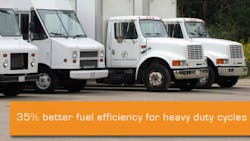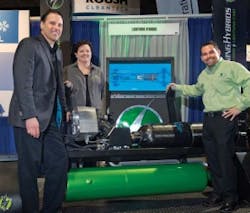I met with officials of Lightning Hybrids at the Work Truck Show, held earlier this year (as it is every year) in Indianapolis. Lightning Hybrids held a press conference and allowed show attendees to test drive a delivery truck equipped with a hybrid hydraulic drive. It was fun and interesting to drive the vehicle, but a conversation with company officials clarified some points I had pondered about hydraulic hybrids.
For example, what type of application is best suited to hydraulic hybrids? Are frequent stops more cost-effective than occasional stops? Do heavier vehicles lend themselves to the benefits of hydraulic hybrids more than lighter vehicles do?
I posed these questions to Tim Reeser, president and co-founder of Lightning Hybrids. Tim said heavier trucks benefit from hydraulic hybrid technology more than lighter ones do. That's because a lot of fuel is burned accelerating a conventional vehicle up to operating speed. With a hydraulic hybrid, energy stored in accumulators is used to help accelerate the vehicle, so much less fuel is burned, especially when the vehicle is started from rest.
Tim also revealed that a vehicle needs to make at least two stops per mile to make a hydraulic hybrid drive practical. On the other hand, too-frequent stopping is also impractical because the vehicle rarely rarely builds up enough speed to store substantial energy from braking. Ten to 12 stops per mile seems to be the range where hydraulic hybrids offer the greatest potential for higher fuel economy.
But it's not just about fuel economy. Because the hydraulic hybrid drive can reduce fuel consumption up to 35%, emissions are also reduced. The hybrid drive also drastically reduces break wear. This translates directly into lower vehicle operating and maintenance costs.
To learn more about hydraulic hybrids, click here to view an article from earlier this year describing a hydraulic hybrid drive used in a transport vehicle. Click here to read an article describing composite accumulators, a key component of hydraulic hybrid drives due to their light weight. Not only do composite accumulators weigh a fraction of their steel counterparts of the same size, they can also be made in larger sizes. For example, manufacturers off steel bladder accumulators generally in sizes to 15 to 20 gal. However, composite accumulators can be made in sizes to 30 gal, so systems requiring large accumulator volumes can probably get by with fewer accumulators by specifying the composite variety.
About the Author
Alan Hitchcox Blog
Editor in Chief
Alan joined Hydraulics & Pneumatics in 1987 with experience as a technical magazine editor and in industrial sales. He graduated with a BS in engineering technology from Franklin University and has also worked as a mechanic and service coordinator. He has taken technical courses in fluid power and electronic and digital control at the Milwaukee School of Engineering and the University of Wisconsin and has served on numerous industry committees.

Leaders relevant to this article:

